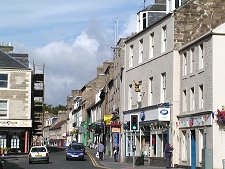 Crossgate |
For much of the past millennium Cupar was the county town of Fife. It inherited this role from the coastal village of Crail in 1214. It lost it to the new town of Glenrothes on the creation of the Fife Regional Council in 1974.
At about the time it became county town, Cupar also acquired a castle. This, too, was later lost, though its probable location, in Castlefields, remains.
Much of the early wealth so evident in the buildings you see in Cupar today was based on the wool trade, and on the town's central location as a market serving a large part of eastern Fife. This received a setback after the Black Death struck Cupar in 1350, and as a result some of the town's dominance was lost to St Andrews. On the whole, however, Cupar continued to do well and by 1827 a visitor recorded it as "a decidedly prosperous town".
The early nineteenth century saw Cupar as a centre for financial services, despite the failure through mismanagement of the Fife Banking Company in 1825. A new county headquarters was built in 1817, and the local newspaper, the Fife Herald, was founded in 1822. By 1825, Cupar was home to four breweries, none of which remain in production today.
A major development took place in 1847, with the arrival in Cupar of the Edinburgh and Northern Railway. The town has managed to retain its station, now on the Edinburgh to Dundee line as it crosses Fife: a fact that helps sustain its prosperity into the 21st Century.
A walk around Cupar today reveals a remarkably bustling town that remains the natural centre of a large part of eastern Fife. Much of the bustle centres on the shopping streets that converge on the Unicorn surmounted Mercat Cross.
A particular testament to Cupar's historic wealth and importance is its fine and varied collection of churches. Especially striking is St John's Church in Bonnygate, built in 1878. Viewed from the street its 150ft spire seems impossibly tall for so narrow a church.
Much older is the interestingly named Cupar Old and St Michael of Tarvit Parish Church, in Kirkgate. The tower dates back to 1415, though the church itself was rebuilt in 1785. One of the bells in the belfry dates back to 1485. Bonnygate is also fronted by the gable and towers of the Baptist Church.
Beyond its more obvious highlights, Cupar throws up a range of interesting insights for the curious visitor. The River Eden flows swiftly through Cupar within its modern defensive banks. Close to the town centre a steel fabrication company stores its stock of steel beams and bars overhanging the river, suggesting that whatever the use put to it in the past, the Eden is not much navigated today.
Just beyond, the river flows through a large and attractive town park. Here, too, you will find the town's large war memorial surmounted by a striking winged statue.
A mile and a half south of Cupar is Scotstarvit Tower, close to another attraction the Hill of Tarvit mansion house.
 St Catherine Street and Corn Exchange Tower |

|
|
|
Visitor InformationView Location on MapWhat3Words Location: ///badminton.banks.spike |
 St John's Church |
 River Eden and Park |
 Baptist Church |



